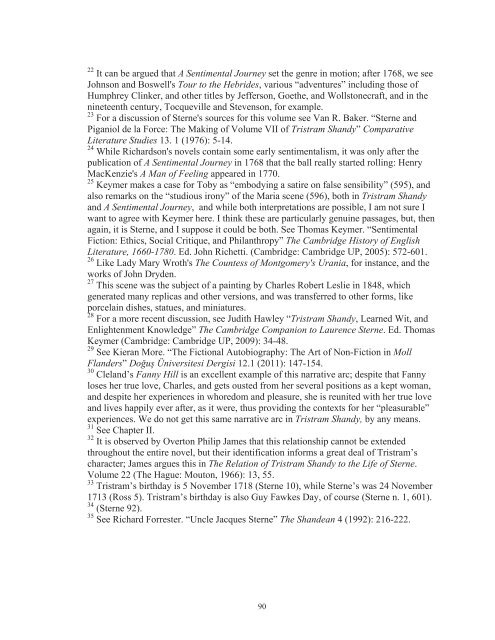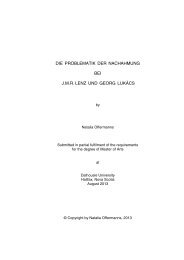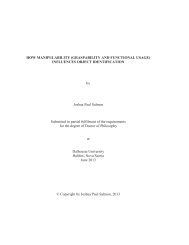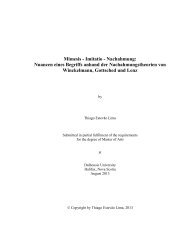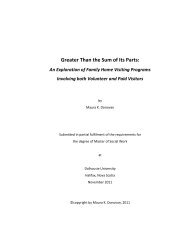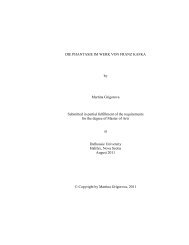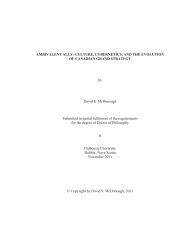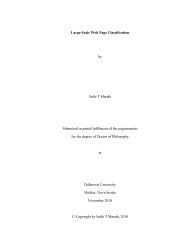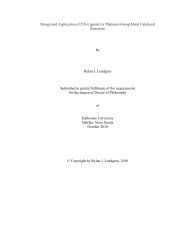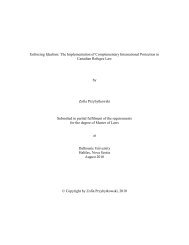ADAPTING TRISTRAM SHANDY by Adria Young Submitted in ...
ADAPTING TRISTRAM SHANDY by Adria Young Submitted in ...
ADAPTING TRISTRAM SHANDY by Adria Young Submitted in ...
Create successful ePaper yourself
Turn your PDF publications into a flip-book with our unique Google optimized e-Paper software.
22<br />
It can be argued that A Sentimental Journey set the genre <strong>in</strong> motion; after 1768, we see<br />
Johnson and Boswell's Tour to the Hebrides, various “adventures” <strong>in</strong>clud<strong>in</strong>g those of<br />
Humphrey Cl<strong>in</strong>ker, and other titles <strong>by</strong> Jefferson, Goethe, and Wollstonecraft, and <strong>in</strong> the<br />
n<strong>in</strong>eteenth century, Tocqueville and Stevenson, for example.<br />
23<br />
For a discussion of Sterne's sources for this volume see Van R. Baker. “Sterne and<br />
Piganiol de la Force: The Mak<strong>in</strong>g of Volume VII of Tristram Shandy” Comparative<br />
Literature Studies 13. 1 (1976): 5-14.<br />
24<br />
While Richardson's novels conta<strong>in</strong> some early sentimentalism, it was only after the<br />
publication of A Sentimental Journey <strong>in</strong> 1768 that the ball really started roll<strong>in</strong>g: Henry<br />
MacKenzie's A Man of Feel<strong>in</strong>g appeared <strong>in</strong> 1770.<br />
25<br />
Keymer makes a case for To<strong>by</strong> as “embody<strong>in</strong>g a satire on false sensibility” (595), and<br />
also remarks on the “studious irony” of the Maria scene (596), both <strong>in</strong> Tristram Shandy<br />
and A Sentimental Journey, and while both <strong>in</strong>terpretations are possible, I am not sure I<br />
want to agree with Keymer here. I th<strong>in</strong>k these are particularly genu<strong>in</strong>e passages, but, then<br />
aga<strong>in</strong>, it is Sterne, and I suppose it could be both. See Thomas Keymer. “Sentimental<br />
Fiction: Ethics, Social Critique, and Philanthropy” The Cambridge History of English<br />
Literature, 1660-1780. Ed. John Richetti. (Cambridge: Cambridge UP, 2005): 572-601.<br />
26<br />
Like Lady Mary Wroth's The Countess of Montgomery's Urania, for <strong>in</strong>stance, and the<br />
works of John Dryden.<br />
27<br />
This scene was the subject of a pa<strong>in</strong>t<strong>in</strong>g <strong>by</strong> Charles Robert Leslie <strong>in</strong> 1848, which<br />
generated many replicas and other versions, and was transferred to other forms, like<br />
porcela<strong>in</strong> dishes, statues, and m<strong>in</strong>iatures.<br />
28<br />
For a more recent discussion, see Judith Hawley “Tristram Shandy, Learned Wit, and<br />
Enlightenment Knowledge” The Cambridge Companion to Laurence Sterne. Ed. Thomas<br />
Keymer (Cambridge: Cambridge UP, 2009): 34-48.<br />
29<br />
See Kieran More. “The Fictional Autobiography: The Art of Non-Fiction <strong>in</strong> Moll<br />
Flanders” Do�u� Üniversitesi Dergisi 12.1 (2011): 147-154.<br />
30<br />
Cleland’s Fanny Hill is an excellent example of this narrative arc; despite that Fanny<br />
loses her true love, Charles, and gets ousted from her several positions as a kept woman,<br />
and despite her experiences <strong>in</strong> whoredom and pleasure, she is reunited with her true love<br />
and lives happily ever after, as it were, thus provid<strong>in</strong>g the contexts for her “pleasurable”<br />
experiences. We do not get this same narrative arc <strong>in</strong> Tristram Shandy, <strong>by</strong> any means.<br />
31<br />
See Chapter II.<br />
32<br />
It is observed <strong>by</strong> Overton Philip James that this relationship cannot be extended<br />
throughout the entire novel, but their identification <strong>in</strong>forms a great deal of Tristram’s<br />
character; James argues this <strong>in</strong> The Relation of Tristram Shandy to the Life of Sterne.<br />
Volume 22 (The Hague: Mouton, 1966): 13, 55.<br />
33<br />
Tristram’s birthday is 5 November 1718 (Sterne 10), while Sterne’s was 24 November<br />
1713 (Ross 5). Tristram’s birthday is also Guy Fawkes Day, of course (Sterne n. 1, 601).<br />
34<br />
(Sterne 92).<br />
35<br />
See Richard Forrester. “Uncle Jacques Sterne” The Shandean 4 (1992): 216-222.<br />
90


